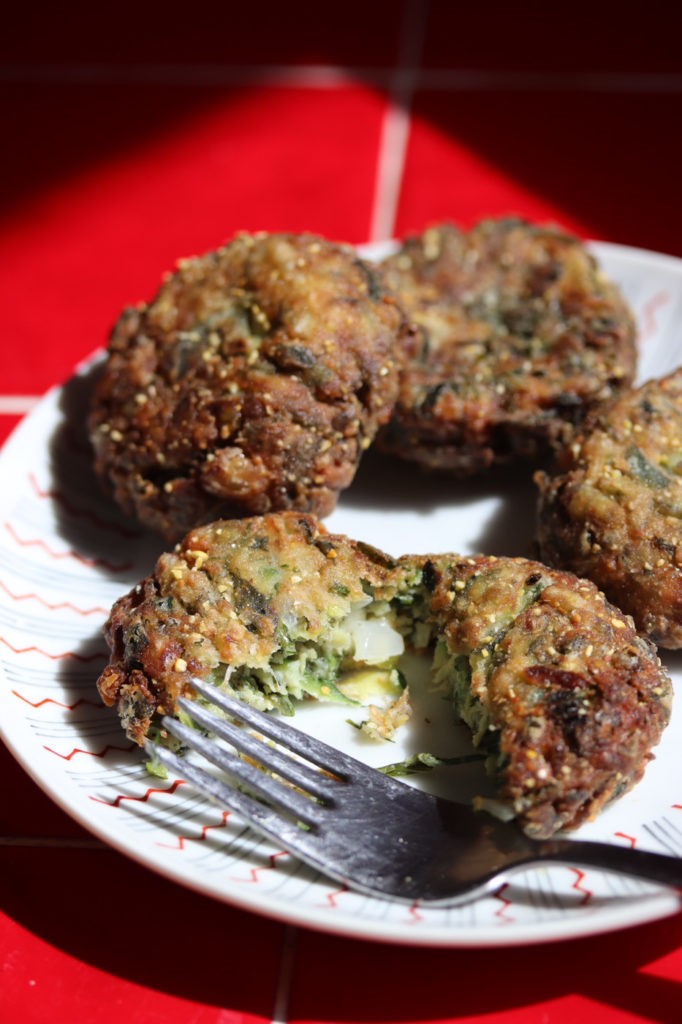
Kolokithokeftedes: A Story of Greek Flavors in Fritter Form
Yield: 12 fritters
Whether it’s biting into a homemade spinach pie or cutting into a piece of creamy feta, the Greek food flavor palate is a familiar one. With the exception of regional specialties, the average Greek home typically cooks from a canon of traditional recipes hallmarked by ingredients and flavors reflecting Greece’s rich landscape and history. Together, these dishes make up the heart of Greek cooking and define the country’s cuisine.
Two items of wide popularity on this ingredient spectrum are herbs and feta, both of which are used vastly and diversely across the Greek menu. Greece’s herbaceous profile distinguishes its food from other cuisines in that it does not rely heavily on savory or warm spices. Fresh and dried herbs are used as ingredients, not just as garnishes, like bountiful bunches of dill, mint and parsley combined with dried oregano and thyme.
This celebration of herbs is also reflected in weekly open-air markets, or laiki, where vegetable stands selling greens of all shades and varieties create a pantone of produce, from dark and leafy standbys to precious and seasonal delicacies. These greens reflect the diverse landscape of Greece, where wild herbs and greens pepper hillsides throughout the country. This wide availability across geographic regions is a predominant reason herbs are so dominant in Greek cooking.
Feta is another commonly used product and an immense source of pride to the Greek. It is the cheese. Feta has even earned PDO (protected designation of origin) status in the European Union, which means E.U. products labeled “feta” must be brined and made exclusively of sheep’s milk, or sheep’s and goat’s milk, from specific regions in Greece.
A classic dish that highlights the timeless ingredients of herbs and feta is kolokithokeftedes. Keftedes refers to fritters, and kolokitho refers to squash, pumpkin or similar. Fritters are popular in Greece, particularly when summer bounties yield troves of seasonal produce. In this recipe, herbs and grated zucchini are combined with feta, egg, and the lightest touch of flour, and are then fried together. Fragrant and packed with greens, kolokithokeftedes are both satisfying without being overfilling. They’re the perfect bite during hot summer nights.
This recipe was published in The At Home Issue of Life & Thyme Post, our quarterly newspaper shipping exclusively to L&T members. Get your copy.
Ingredients
- 2-3 medium zucchinis, grated
- 3 scallions, finely chopped
- ½ yellow onion, diced
- ½ large bunch dill, finely chopped
- ½ large bunch mint, finely chopped
- 1 tbsp. dried herbs (recommended combination: thyme, oregano, marjoram)
- 1 egg
- 4 oz. feta
- 1 cup all-purpose flour
- Plenty of a neutral oil, like olive or grapeseed
- Salt
- Pepper
Missing ingredients? We got you.
Find and support independent producers, farmers and purveyors in your local area with our crowdsourced directory, Supply Home Cooks.
Method
- In a pan on medium heat, sauté the onion and scallions in a generous dash of olive oil; season lightly with salt. Cook until translucent, for about 8 to 10 minutes. Set aside to cool to room temperature.
- Meanwhile, grate your zucchinis and place the gratings into a strainer that’s set on top of a bowl. Season lightly with salt. Set aside for a few minutes, and then start wringing out the water from the grated zucchini using your hands. Be aggressive—you’ll see a lot of water coming out, as well as the volume of the grated zucchini reducing a bit. You want to get a good amount of the water out, likely around 1 cup.
- In a large bowl, add the zucchini, dill, mint, cooked and cooled onion and scallion, dried herbs, feta, egg, and ¼ cup of flour. Season with salt and pepper.
- Using a spoon, gently start to mix everything together. Then use your hands to combine, squeezing through the mixture to help everything fully incorporate. Once well-combined, cover the top of the bowl and place in the refrigerator for about 30 minutes to chill.
- Meanwhile, in a wide shallow bowl, add the rest of the flour with a dash of salt and pepper, and mix together.
- When you’re ready to start frying the fritters, take the mixture out of the fridge and slowly bring your oil to heat in the frying pan. I do half olive oil and half grapeseed oil, but whatever neutral oil you have on-hand is fine. You just want the oil to be about 1 to 1 ½ inches deep so it reaches halfway on the fritters.
- When the oil is ready, you can test it by putting a tiny bit of the fritter mixture into the pan. If the oil starts to gently bubble around it, it’s ready. If there are no bubbles or if the bubbling is too vigorous, adjust your heat. I fry on medium-low because my cast iron retains a lot of heat.
- Start shaping the patties by placing about a ¼ cup of the mixture in your hand. Shape a patty compactly, giving a gentle squeeze to expel excess liquid. If the patty is very loose or too watery, it will likely break when placed in the flour or when frying. Place the patty in the flour, lightly coating both sides, and then gently place it into the oil using a spatula.
- Fry each side until they just start to turn golden brown, for about 8 minutes per side. Like pancakes, the first batch always takes longer. Sometimes my first batch can take more than 8 minutes and the second can only take 4 to 6 minutes per side, so keep an eye on them.
- Once fried, remove and place fritters on a plate with a paper towel to absorb excess oil. Serve kolokithokeftedes immediately, and top with optional yogurt.






Our comments section is for members only.
Join today to gain exclusive access.